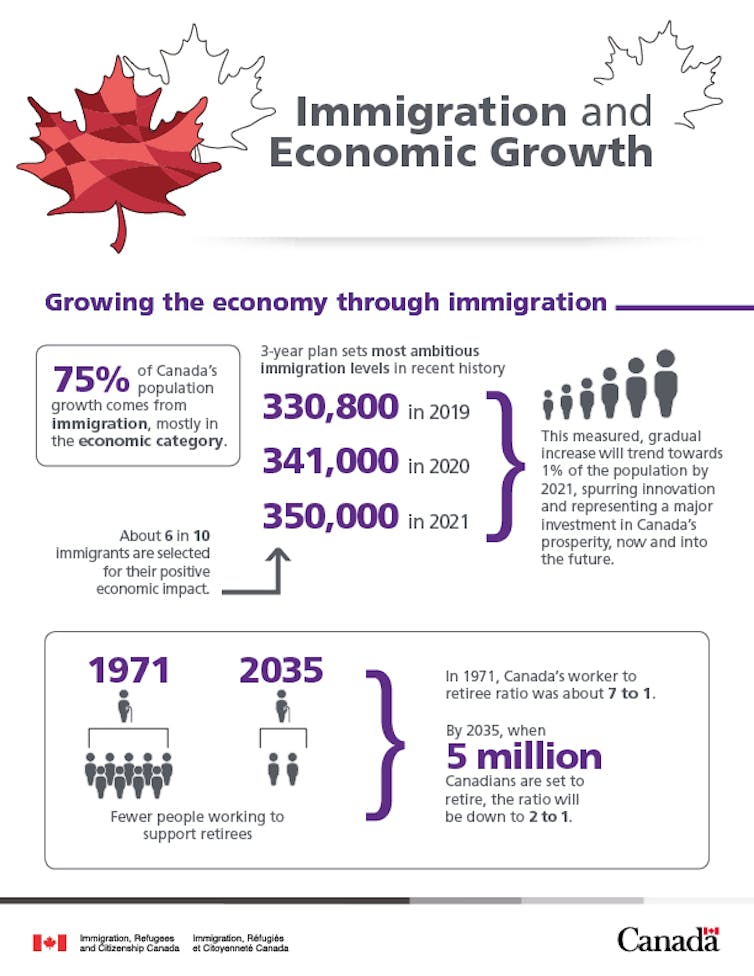Canada News
How to build a better Canada after COVID-19: Rethinking immigration can boost the economy

Canadian governments, regardless of the party in power, have traditionally increased immigration numbers as a strategy to offset the country’s declining domestic birthrate. A continual flow of immigrants is essential for economic stability and growth. (File photo: Sasan Hezarkhani/Unsplash)
This story is part of a series that proposes solutions to the many issues exposed during the coronavirus pandemic and what government and citizens can do to make Canada a better place.
The coronavirus pandemic hasn’t stopped the flow of goods coming into Canada. That’s because countries around the world worked together to keep trade markets open for business. But Canada faces a potential crisis if its borders remain closed to people for a prolonged period of time.
Canadian governments, regardless of the party in power, have traditionally increased immigration numbers as a strategy to offset the country’s declining domestic birthrate. A continual flow of immigrants is essential for economic stability and growth.

How then can you maintain economic growth if no new immigrants are allowed into the country?
Every crisis can lead to new opportunities. And we’ve already seen challenges that emerged during the pandemic lead to innovative government programs. The same should happen with Canada’s immigration policy.
While the pandemic has temporarily closed the territorial borders to all foreigners for non-essential travel, there’s an opportunity to keep our “virtual” borders open to the best and brightest workers who want to come to Canada.
One million new immigrants by 2021
The current immigration plan calls for more than one million new permanent residents between 2019 and 2021. Of these newcomers, the majority will be economic migrants, coming through various provincial and federal programs such as the Federal Skilled Worker Class and the Provincial Nominee Program.
Illustrating the vital role of immigration for Canada, with emphasis on economic gain and global competitiveness, Canada’s then minister of immigration, Ahmed Hussen, stated in 2018: “The new multi-year immigration levels plan supports Canadian employers and businesses by ensuring they have the skilled labour they need to spur innovation and help to keep our country at the forefront of the global economy.”

(Immigration, Refugees and Citizenship Canada)
Some of the dilemmas that Canada will face in the post-pandemic recovery period will involve how to continue attracting the best and brightest, what sectors of the economy should be prioritized and how to deal with essential work like agriculture.
Unprecedented challenges
I have studied highly skilled and lower-skilled migration in Europe and internationally for over 20 years, with a special interest in how migration policy interacts with other sectors such as agriculture, the care industry and the competition for talent. But the COVID-19 pandemic poses unprecedented challenges for Canada’s immigration policy because of the level of uncertainty that the whole world is facing.
What’s happened to the government’s plans to attract “the best and brightest from around the world” — people who will be fundamental to the country’s economic future?
For more than three months, Canada has temporarily stopped processing work permit or permanent residency applications. This presents many challenges for businesses and for workers and their families.
While working remotely is a possibility for most highly skilled workers in Canada who are in non-essential sectors, that’s not an option for those who have a job offer but are still abroad. They cannot receive a work permit, a Social Insurance Number unless they enter the country. They also can’t be paid without a SIN number. There are important consequences for organizations that seek workarounds and do not respect labour laws.
Digital work permits
Technology can offer a solution to this impasse. A security-proof digital work permit and a social identification number could be assigned remotely to allow these “virtual immigrants” to start working remotely with their Canadian employers while they wait for the entry ban to be lifted.
The permit could be for three or six months and would automatically be replaced by the regular work permit and SIN if the ban is lifted and the worker moves to Canada. The worker and employer would commit to honouring their contract by coming to Canada within 90 days of lifting the entry restrictions.
This would give everyone — government, employers, workers and their families — both the necessary guarantees and flexibility to deal with this unexpected disruption.
But are those workers truly needed now — especially given the country’s record unemployment rate since the outbreak of the pandemic?
Canadian immigration policy involves long-term planning related to the country’s demographic composition, growth (or rather decline, without immigration), key industries and efforts to attract new immigrants to the smaller regional centres across this vast country.
In February, just before the pandemic was declared, Minister of Immigration, Refugees and Citizenship Marco Mendicino told the Canadian Club in Toronto that Canada welcomed 341,000 new immigrants last year. He then added: “In 2020, the future of Canada hinges on immigration.” But the current situations means it seems unlikely Canada will be able to meet its immigration targets this year or next.
Not a job competition
Unemployment and underemployment data from April show temporary workers, those with less than one year at their last job or people not covered by a union or collective agreement, were hit the hardest by COVID-19. While it is imperative to provide for these workers and their families, these newly unemployed workers are not in competition for the same jobs as those to be filled by the highly skilled newcomers attracted by the Express Entry or Global Talent immigration streams.
As we go through and hopefully leave behind the pandemic, Canada needs to build a stronger health sector including industries that produce gowns, masks and gloves or health-care equipment like ventilators. The medical and pharmaceutical research sector should also remain a top priority. Transnational co-operation is key to Canadian entrepreneurship. Such sectors can only gain from highly skilled migrants who bring to the country innovative ideas, much needed skills and connections to other countries and continents.
New ideas needed
While rethinking policies about bringing highly skilled immigrants to Canada, new ideas are also needed for lower-skilled workers who are essential to the economy.
The deaths of Mexican farm workers in southern Ontario have raised an important debate about the responsibility of employers, but also the need for monitoring the health and the working conditions of those we bring to Canada to do jobs that are essential. There has been a growing awareness that the temporary foreign worker program in agriculture needs both a short- and long-term overhaul.
We need to consider how agricultural policy and migration policy can work hand in hand to promote better working and living conditions for migrant farm workers. One idea could be the expansion of a pilot project launched in May that will allow a small number of migrant agriculture workers to apply for permanent residency.
The many challenges that both highly skilled and low skilled migrants face during the pandemic can be turned into an opportunity that would help Canada’s post-COVID-19 economic recovery.![]()
Anna Triandafyllidou, Canada Research Excellence Chair in Migration and Integration, Ryerson University
This article is republished from The Conversation under a Creative Commons license. Read the original article.





















